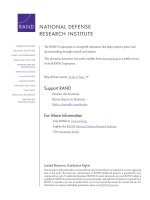NANOTECHNOLOGY APPLICATIONS TO TELECOMMUNICATIONS AND NETWORKING pot
Bạn đang xem bản rút gọn của tài liệu. Xem và tải ngay bản đầy đủ của tài liệu tại đây (12.38 MB, 508 trang )
TEAM LinG
NANOTECHNOLOGY
APPLICATIONS TO
TELECOMMUNICATIONS
AND NETWORKING
ffirs.qxd 9/27/2005 10:40 AM Page i
ffirs.qxd 9/27/2005 10:40 AM Page ii
NANOTECHNOLOGY
APPLICATIONS TO
TELECOMMUNICATIONS
AND NETWORKING
Daniel Minoli
Managing Director
Leading-Edge Networks Incorporated
A JOHN WILEY & SONS, INC., PUBLICATIO
N
ffirs.qxd 9/27/2005 10:40 AM Page iii
Copyright © 2006 by John Wiley & Sons, Inc. All rights reserved.
Published by John Wiley & Sons, Inc., Hoboken, New Jersey.
Published simultaneously in Canada.
No part of this publication may be reproduced, stored in a retrieval system, or transmitted in any form
or by any means, electronic, mechanical, photocopying, recording, scanning, or otherwise, except as
permitted under Section 107 or 108 of the 1976 United States Copyright Act, without either the prior
written permission of the Publisher, or authorization through payment of the appropriate per-copy fee to
the Copyright Clearance Center, Inc., 222 Rosewood Drive, Danvers, MA 01923, 978-750-8400, fax
978-646-8600, or on the web at www.copyright.com. Requests to the Publisher for permission should
be addressed to the Permissions Department, John Wiley & Sons, Inc., 111 River Street, Hoboken, NJ
07030, (201) 748-6011, fax (201) 748-6008, or online at />Limit of Liability/Disclaimer of Warranty: While the publisher and author have used their best efforts in
preparing this book, they make no representations or warranties with respect to the accuracy or
completeness of the contents of this book and specifically disclaim any implied warranties of
merchantability or fitness for a particular purpose. No warranty may be created or extended by sales
representatives or written sales materials. The advice and strategies contained herein may not be
suitable for your situation. You should consult with a professional where appropriate. Neither the
publisher nor author shall be liable for any loss of profit or any other commercial damages, including
but not limited to special, incidental, consequential, or other damages.
For general information on our other products and services please contact our Customer Care
Department within the U.S. at 877-762-2974, outside the U.S. at 317-572-3993 or fax 317-572-4002.
Wiley also publishes its books in a variety of electronic formats. Some content that appears in print
may not be available in electronic format. For information about Wiley products, visit our web site at
www.wiley.com
Library of Congress Cataloging-in-Publication Data:
Minoli, Daniel, 1952–
Nanotechnology applications to telecommuications and networking / by Daniel Minoli.
p. cm.
Includes bibliographical references and index.
ISBN-13 978-0-471-71639-6
ISBN-10 0-471-71639-1 (cloth)
1. Telecommunication—Equipment and supplies. 2. Computer networks—Equipment and
supplies. 3. Nanotechnology. I. Title.
TK5103.M474 2005
621.382
–
dc22 2004063825
Printed in the United States of America
10987654321
ffirs.qxd 9/27/2005 10:40 AM Page iv
For Anna
And for my Father and Mother
ffirs.qxd 9/27/2005 10:40 AM Page v
ffirs.qxd 9/27/2005 10:40 AM Page vi
vii
CONTENTS
Preface xv
About the Author xix
1. Nanotechnology and Its Business Applications 1
1.1 Introduction and Scope 1
1.1.1 Introduction to the Nanoscale 1
1.1.2 Plethora of Potential Applications 7
1.1.3 Challenges and Opportunities 13
1.1.4 Technology Scope 15
1.1.5 Commercialization Scope 18
1.1.6 Opportunities of the Technology and the 21st Century
Nanotechnology Research and Development Act of 2003 22
1.2 Present Course of Investigation 23
2. Basic Nanotechnology Science—Physics 25
2.1 Approach and Scope 26
2.2 Basic Science 27
2.2.1 Atoms 27
2.2.2 Key Subatomic Particles 28
2.2.3 Atomic Structure 36
2.2.4 Substances and Elements 39
2.2.5 Nomenclature and Periodic Table 45
2.2.6 Making Compounds 47
2.3 Basic Properties of Conductors, Insulators, and Semiconductors 49
2.4 Basic Properties of Silicon and Basics of Transistor Operation 51
2.4.1 Transistors 51
2.4.2 Manufacturing Approaches 53
2.4.3 Manufacturing Limitations 55
2.5 Conclusion 58
ftoc.qxd 9/28/2005 11:05 AM Page vii
viii CONTENTS
3. Basic Nanotechnology Science—Chemistry 59
3.1 Introduction and Background 59
3.2 Basic Chemistry Concepts 60
3.2.1 Physical Aspects 60
3.2.2 Bonding 64
3.2.3 Basic Formulation/Machinery of Chemical Reactions 73
3.2.4 Chemistry of Carbon 74
3.2.5 Graphical View of the Atomic Structure Of Materials 78
3.3 Conclusion 86
4. Nanotubes, Nanomaterials, and Nanomaterial Processing 87
4.1 Introduction 88
4.2 Basic Nanostructures 95
4.2.1 Carbon Nanotubes 95
4.2.2 Nanowires 101
4.2.3 Nanocones 106
4.2.4 Applications of Nanotubes, Nanowires, and Nanocones 106
4.2.5 Quantum Dots 111
4.2.6 Quantum Dots Nanocrystals 115
4.2.7 Ultrananocrystalline Diamond 117
4.2.8 Diamondoids 117
4.2.9 Nanocomposites 117
4.2.10 Thin-Films 120
4.2.11 Nanofoam 122
4.2.12 Nanoclusters 122
4.2.13 Smart Nanostructures 122
4.2.14 Environmental Issues for Nanomaterials 122
4.3 Manufacturing Techniques 123
4.3.1 General Approaches 123
4.3.2 Self-Assembly Methods 127
4.4 System Design 132
4.5 Conclusion 133
5. Nanophotonics 134
5.1 Introduction and Background: A Plethora of Opportunities 134
5.2 General Photonics Trends 137
5.3 Basic Nanophotonics 147
ftoc.qxd 9/28/2005 11:05 AM Page viii
CONTENTS ix
5.3.1 Photonic Crystals 150
5.3.2 Photonic Crystal Fibers 153
5.3.3 Photonic Crystal Lasers 154
5.3.4 Plasmonics 155
5.3.5 Integration 155
5.3.6 New Technologies 156
5.3.7 Instrumentation 157
5.4 Photonic Crystals 157
5.4.1 Overview 157
5.4.2 Applicability of Technology 159
5.4.3 Fabrication 161
5.5 Telecom Applications of Photonic Crystals 162
5.5.1 Quantum Cascade Lasers 162
5.5.2 Photonic Crystal Fibers 163
5.5.3 Superprism Effect in Photonic Crystal 164
5.6 Plasmonics 165
5.6.1 Study of Light at the Nanoscale 165
5.6.2 Physics of the Near-Field 173
5.7 Advanced Topics 177
5.7.1 Nonlinear Optics 177
5.7.2 Confinement and Microresonators 179
5.7.3 Quantum Optics 183
5.7.4 Superlenses 184
5.8 Conclusion 184
6. Nanoelectronics 185
6.1 Introduction 186
6.1.1 Recent Past 186
6.1.2 The Present and its Challenges 189
6.1.3 Future 193
6.2 Overview of Basic Nanoelectronic Technologies 199
6.2.1 Single Electron Devices 199
6.2.2 Quantum Mechanical Tunnel Devices 202
6.2.3 Spin Nanoelectronics (Spintronics) 204
6.2.4 Molecular Nanoelectronics 205
6.2.5 Fault Tolerant Designs 207
6.2.6 Quantum Cellular Automata 208
6.2.7 Quantum Computing 209
ftoc.qxd 9/28/2005 11:05 AM Page ix
x CONTENTS
6.3 Additional Details on Nanoelectronic Systems 210
6.3.1 Quantum Dots and Quantum Wires 211
6.3.2 Quantum Computing 215
6.3.3 Fabrication Methods and Techniques for
Nanoelectronics 218
6.3.4 Microscopy Tools for Nanoelectronics 226
6.3.5 Microelectromechanical Systems and
Microoptoelectromechanical Systems
Applications 229
6.4 Conclusion 230
Appendix A Historical Developments Related to Atomic Theory and
Additional Perspectives 231
Appendix B Brief Introduction to Hilbert Spaces 237
Appendix C Reference Information 241
Appendix D Basic Nanotechnology Science—Quantum Physics 248
D.1 Physics Developments Leading to a
Quantum Model 248
D.1.1 Experimental Highlights 249
D.1.2 Basic Mechanisms 252
D.2 Quantum Concepts 254
D.2.1 Electron Density of Atoms 255
D.2.2 Energy Levels 266
D.2.3 Heisenberg’s Uncertainty Principle 272
D.2.4 Motion in Two Dimensions 275
D.2.5 Ψ—The Probability Amplitude 275
D.2.6 The Hydrogen Atom—Developing the
Hydrogenic Atomic Orbital Concepts 279
D.2.7 Formal Application of Theory 288
D.3 Other Topics 293
D.3.1 Field Theory 293
D.3.2 String Theory 297
D.3.3 A Few Words About the Current Understanding
of Physics 297
Appendix E Mechanical Molecular Models and Quantum
Aspects of Chemistry 299
E.1 Mechanical Molecular Models 299
E.2 Quantum Chemistry/Linear Combination of
Atomic Orbitals 303
ftoc.qxd 9/28/2005 11:05 AM Page x
CONTENTS xi
E.2.1 Linear Combination of Atomic
Orbitals Approach 304
E.2.2 Hartree-Fock (HF) Approach 306
E.2.3 Configuration Interaction Method 307
E.2.4 Semiempirical Molecular Orbital Methods 307
E.2.5 Modeling for Nanomaterials 307
Appendix F Basic Molecular/Nanotechnology Instrumentation 308
F.1 Overview of Generic Microscopy Tools 310
F.1.1 Laser Scanning Confocal Microscopy 315
F.1.2 Secondary Ion Mass Spectrometry (SIMS) 315
F.1.3 Time-of-Flight Secondary Ion Mass
Spectrometry (TOF-SIMS) 315
F.1.4 Scanning Electron Microscopy (SEM) 316
F.1.5 Field Emission Scanning Electron Microscopy
(FE-SEM) 316
F.1.6 Transmission Electron Microscopes (TEMs) 316
F.1.7 Energy Dispersive X-Ray Spectrometry
(EDS) 316
F.1.8 Auger Electron Spectrometry (AES) and
Scanning Auger Microscopy (SAM) 317
F.1.9 X-Ray Photoelectron Spectroscopy (XPS)
and Electron Spectroscopy for Chemical
Analysis (ESCA) 317
F.1.10 Rutherford Backscattering Spectrometry
(RBS) 317
F.1.11 Hydrogen Forward Scattering Spectrometry
(HFS) 317
F.1.12 Particle Induced X-Ray Emission (PIXE) 318
F.1.13 Atomic Force Microscopy (AFM), Scanning
Tunneling Microscopy (STM), and Magnetic
Force Microscopy (MFM) 318
F.1.14 Total Reflection X-Ray Fluorescence
(TXRF) 318
F.1.15 Fourier Transform Infrared Spectrometry
(FTIR) 318
F.1.16 µ-Raman Spectroscopy 319
F.1.17 Gas Chromatography/Mass Spectrometry
(GC/MS) 319
F.1.18 Enhanced Sensitivity for Quantitation with
Tandem Mass Spectrometry 321
F.1.19 X-Ray Fluorescence (XRF) 322
ftoc.qxd 9/28/2005 11:05 AM Page xi
xii CONTENTS
F.1.20 Focused Ion Beam (FIB) 322
F.1.21 Near-Field Scanning Optical Microscopy
(NSOM) and Near-Field Optical
Spectroscopy (NFOS) 323
F.2 Details on Some Key Systems 324
F.2.1 Contact Mode AFM 324
F.2.2 Magnetic AC Mode (MAC Mode) 325
F.2.3 Acoustic AC Mode (AAC Mode) 325
F.2.4 Current-Sensing AFM 327
F.2.5 Force Modulation AFM 328
F.2.6 Phase Imaging 329
F.2.7 Pulsed Force Mode (PFM) 330
F.2.8 Electrostatic Force Microscopy (EFM) 331
F.2.9 Magnetic Force Microscopy (MFM) 332
F.2.10 Lateral Force Microscopy (LFM) 333
F.2.11 Scanning Tunneling Microscope (STM) 334
Appendix G Quantum Computing 336
G.1 Introduction 336
G.2 Fundamental Theoretical Challenges 337
G.2.1 Quantum Algorithms 338
G.2.2 Quantum Complexity Theory 338
G.2.3 Fault-Tolerant Quantum Computing 338
G.2.4 Simulation of Quantum Systems 339
G.3 Quantum Computation Historical Review 339
G.3.1 A Short Summary of Significant
Breakthroughs in Quantum Information
Theory 339
G.3.2 Current Developments and Directions 343
G.4 Quantum Information Theory 348
G.4.1 Capacities 349
G.4.2 Entanglement and Correlations 352
G.4.3 Cryptographic Primitives 355
G.5 Quantum Computer Architectures 359
G.5.1 Initial Conceptual Development 361
G.5.2 Testing the Components 361
G.5.3 Assembling the Components into
a Working Device 361
ftoc.qxd 9/28/2005 11:05 AM Page xii
G.5.4 Scaling up the Architecture 362
G.5.5 “Type-II” Quantum Computing 363
G.6 Decoherence Roadblocks for Quantum
Information Processing 363
G.6.1 Theoretical Terminology 363
G.6.2 Studies of Decoherence and Ways to
Overcome It 364
G.6.3 Physical Sources of Decoherence 366
G.6.4 Decoherence Analyses 368
Glossary 371
References 439
Index 479
CONTENTS xiii
ftoc.qxd 9/28/2005 11:05 AM Page xiii
ftoc.qxd 9/28/2005 11:05 AM Page xiv
xv
PREFACE
This is believed to be the first book that takes a view of nanotechnology from a
telecommunications and networking perspective. Nanotechnology refers to the manip-
ulation of materials at the atomic or molecular level. Nanotechnology is getting a lot
of attention of late not only in academic settings and in laboratories around the
world, but also in government and venture capitalists’ initiatives. There now is a
major drive to commercialize the technology by all sorts of firms, ranging from start-
ups to Fortune 100 companies.
At the start of the decade, Charles Vest, the president of MIT, observed: “We are
just beginning to understand how to use nanotechnology to build devices and
machines that imitate the elegance and economy of nature. The gathering nanotech-
nology revolution will eventually make possible a huge leap in computing power,
vastly stronger yet much lighter materials, advances in medical technologies, as well
as devices and processes with much lower energy and environmental costs.”
Nanotechnology is a nanometer-level bottom-up
1
assembly approach that allows
developers to engineer particles at the molecular level, building them up to the “right
size,” with engineered functional properties. A nanometer is one billionth of a meter
(a meter being about 3 ft). Bottom-up process technology provides a control mecha-
nism over development of particles with respect to their size, shape, morphology,
and surface conditions. Because of the challenges involved in working at this micro-
scopic scale of a few nanometers, research and engineering efforts involving manip-
ulation of components as “large” as 100nm are typically included in the field of
nanotechnology. Atoms are typically between one-tenth and one-half of a nanometer
wide.
Research and development topics in nanotechnology range from molecular manip-
ulation to nanomachines (microscopic devices that can themselves carry out tasks at
the atomic or sub-atomic level). While nanomachines represent futuristic initiatives
with relatively little current (commercial) achievement, nanomaterials, nanomaterial
processing, nanophotonics, and nanoelectronics are already resulting (or will do so
in the next 3–5 years) in usable technologies.
In this book we focus on developments and technologies that have the potential
to be used (or are already being used) in communication and networking environments.
Such applications include faster and smaller non-silicon-based processors, faster and
smaller switches (particularly optical switches), and MEMSs (microelectromechanical
1
In the nanotechnology field the term bottom-up is preferred to the (perhaps) more common English-
language term bottoms-up.
fpref.qxd 9/27/2005 10:45 AM Page xv
systems). MEMS are microscale systems (∼100 µm) that include both mechanical
and electrical devices integrated on a single die or chip. MOEMS are microoptical-
electromechanical systems consisting of MEMS devices with integral optical com-
ponents such as mirrors, lenses, filters, laser diodes, emitters or other optics. A
MEMS system may include microfluidic elements, integral microelectronics or ICs,
“lab-on-chip” systems, actuators, micromotors, or sensors. Efforts are already under-
way to create nanoscale MEMSs, also known as NEMSs.
In Chapter 1 we review the basic concepts of nanotechnology and applications.
In Chapters 2 and 3 we cover supportive topics such as physics and chemistry basics
(e.g., electron, atoms, atomic structures, molecules, bonded structures); electrical
properties (e.g., insulators, semiconductors, conductors); and chemical bonds and
reactions. Chapter 2 also provides a basic introduction to transistors, in support of
the discussion to follow in Chapter 6. It turns out that while classical Newtonian
mechanics can predict with precision the motions of masses ranging in size from
microscopic particles to stars, it cannot predict the behavior of the particles in the
atomic domain; at these dimensions quantum theory (physics) comes into play.
Hence, as a spin-off of Chapters 2 and 3, in Appendices D and E we discuss some of
the basic scientific principles that support quantum theory; the reader who may find
these two appendices somewhat demanding may chose to skip this material and
move on to the chapters that follow, which are generally self-contained. In Chapter
4 we look at nanomaterials and nanomaterial processing: Individual nanoparticles
and nanostructures (e.g., nanotubes, nanowires) are discussed. Nanophotonics is dis-
cussed in Chapter 5 (e.g., nanocrystals, nanocrystal fibers). Nanoelectronics (e.g.,
metal nanoclusters, semiconducting nanoclusters, nanocrystals, quantum dots) is
covered in Chapter 6. Both Chapters 5 and 6 provide a discussion of near-term and
longer-term applications in the field of computers, telecommunications, and net-
working. An extensive glossary is also included. Appendix F discusses nanoinstru-
mentation, while Appendix G provides detailed information on quantum computing.
This book is intended as an introduction to the field of nanotechnology for telecom-
munications vendors, researchers, and students who want to start thinking about
the potential opportunities afforded by these emerging scientific developments and
approaches for the next-generation networks to be deployed 5–10 years in the future.
Advanced planning is a valuable and effective exercise. When the author first joined
Bell Telephone Laboratories in 1978, he was involved in planning networks 5–10
years into the future. While, recently, advanced planning and strategic development
have suffered at the hand of the “next-quarter” mentality, it is indeed advantageous
to plan 10 years out, only if for the reason that it takes about 10–15 years to grow a
carrier (such as a CLEC, a hotspot provider, a 3G wireless operator) to turn a profit
from a cold start.
As noted, this book is intended as an introduction to the field. We hope it will
serve as motivation, by raising interest, to continue the line of investigation and
research into the field. We have made every effort to make it relatively self-con-
tained by discussing the introductory fundamental principles involved, and by
providing an extensive glossary. Most professionals outside the field of basic sci-
ences probably have forgotten freshman college physics and chemistry. The most
xvi PREFACE
fpref.qxd 9/27/2005 10:45 AM Page xvi
basic take-aways from these courses are summarized in the book, to facilitate the
discussion of nanotechnology applications.
The reader is encouraged, after reading this text, to seek out additional books that
go into greater detail. Each chapter included here can be supported by an entire book
just covering each individual chapter-level topic.
Finally, it should be noted that nanotechnology is a highly active burgeoning field
at this time, with (hundreds of ) thousands of articles, publications, lectures, semi-
nars, and books available. Given this plethora of research, this book is based liber-
ally on industry sources. In this context, we have made every effort to acknowledge
the source of the material we cover and provide appropriate credit thereof; we hope,
with said diligence, that any unwitting omissions are strictly minimal and/or essen-
tially inconsequential. Hence, while the actual synthesis of the topic(s) as presented
here is original, the intrinsic material itself is based on the 750+ references that we
cite and utilize throughout the body of the text.
Acknowledgement
I would like to thank Mr. Emile A. Minoli for contributions in Chapters 2 and 3.
The cover page shows Daniel Minoli (center front) with a slide rule next to an AM
radio the student trio built based on discrete electronic components. Students Melvin
Lee (left front) and Steven Lightburn (right front) part of the student trio are with
Mr. Tepper (middle front), electronics teacher in a Technical Electronics Laboratory
in Hight School in Brooklyn, NY in the fall of 1970. Two second-row students are
unidentified. As this textbook shows, electronics and electronics density has come
a long way in the past 35 years, and will continue to do so under the thrust of nano-
technology.
D
ANIEL MINOLI
PREFACE xvii
fpref.qxd 9/27/2005 10:45 AM Page xvii
fpref.qxd 9/27/2005 10:45 AM Page xviii
ABOUT THE AUTHOR
Daniel Minoli has many years of telecom, networking, and information technology
(IT) experience for end-users, carriers, academia, and venture capitalists, including
work at ARPA think tanks, Bell Telephone Laboratories, ITT, Prudential Securities,
Bell Communications Research (Bellcore/Telcordia), AT&T, NYU, Rutgers Univer-
sity, Stevens Institute of Technology, and Societe General de Financiament de
Quebec (1975–2001). Recently, he also played a founding role in the launching of
two networking companies through the high-tech incubator Leading Edge Networks
Inc., which he ran in the early 2000s: Global Wireless Services, a provider of secure
broadband hotspot mobile Internet and hotspot VoIP services to high-end marinas; and
InfoPort Communications Group, an optical and gigabit Ethernet metropolitan car-
rier supporting data center/SAN/channel extension and grid computing network
access services (2001–2003). In the recent past, Mr. Minoli was involved (on behalf
of a venture capitalist considering a $15 million investment) in nanotechnology-based
systems using quantum cascade lasers (QCLs) for 10-µm-transmission free space
optics communication systems.
An author of a number of technical references on IT, telecommunications, and data
communications, he has also written columns for ComputerWorld, NetworkWorld, and
Network Computing (1985–2005). He has taught at New York University (Information
Technology Institute), Rutgers University, Stevens Institute of Technology, Carnegie
Mellon University, and Monmouth University (1984–2003). Also, he was a Technology
Analyst At-Large, for Gartner/DataPro (1985–2001); based on extensive hands-on
work at financial firms and carriers, he tracked technologies and wrote around 50 distinct
CTO/CIO-level technical/architectural scans in the area of telephony and data com-
munications systems, including topics on security, disaster recovery, IT outsourcing,
network management, LANs, WANs (ATM and MPLS), wireless (LAN and public
hotspot), VoIP, network design/economics, carrier networks (such as metro Ethernet
and CWDM/DWDM), and e-commerce. Over the years he has advised venture capi-
talists for investments of $150 million in a dozen high-tech companies and has acted
as expert witness in a (won) $11 billion lawsuit regarding a wireless air-to-ground
communication system.
xix
Nanotechnology Applications to Telecommunications and Networking, By Daniel Minoli
Copyright © 2005 John Wiley & Sons, Inc.
flast.qxd 9/27/2005 10:52 AM Page xix
flast.qxd 9/27/2005 10:52 AM Page xx
xx
Nanotechnology Applications to Telecommunications and Networking, By Daniel Minoli
Copyright © 2005 John Wiley & Sons, Inc.
CHAPTER 1
Nanotechnology and Its
Business Applications
1.1 INTRODUCTION AND SCOPE
1.1.1 Introduction to the Nanoscale
Nanotechnology is receiving a lot of attention of late across the globe. The term
nano originates etymologically from the Greek, and it means “dwarf.” The term indi-
cates physical dimensions that are in the range of one-billionth (10
Ϫ9
) of a meter.
This scale is called colloquially nanometer scale, or also nanoscale. One nanometer
is approximately the length of two hydrogen atoms. Nanotechnology relates to the
design, creation, and utilization of materials whose constituent structures exist at the
nanoscale; these constituent structures can, by convention, be up to 100 nm in size.
1–3
Nanotechnology is a growing field that explores electrical, optical, and magnetic
activity as well as structural behavior at the molecular and submolecular level. One
of the practical applications of nanotechnology (but certainly not the only one) is the
science of constructing computer chips and other devices using nanoscale building
elements. This book is a basic practical survey of this field with an eye on comput-
ing and telecom applications.
The nanoscale dimension is important because quantum mechanical (non-
Newtonian) properties of electronics, photons, and atoms are evident at this scale.
Nanoscale structures permit the control of fundamental properties of materials without
changing the materials’ chemical status. Nanostructure, such as nanophotonic devices,
nanowires, carbon nanotubes, plasmonics devices, among others, are planned to be
1
Nanotechnology Applications to Telecommunications and Networking, By Daniel Minoli
Copyright © 2006 John Wiley & Sons, Inc.
1
Measures are relatives; hence, one can talk about something being 1000 nanometers (nm), or 1 microm
(µm), of 10,000 Angstroms (Å). A micron is a unit of measurement representing one-millionth of a meter
and is equivalent to a micrometer. An angstrom is a unit of measurement indicating one-tenth of a
nanometer, or one ten-billionth of a meter (often used in physics and/optics to measure atoms and wave-
lengths of light).
2
Atoms are typically between 0.1 and 0.5 nm wide.
3
For comparison, a human hair is between 100,000 and 200,000nm in diameter and a virus is typically
100 nm wide.
Minoli_ch01.qxd 9/27/2005 8:49 AM Page 1
incorporated into telecommunication components and into microprocessors in the
next few years, leading to more powerful communication systems and computers—
these nanostructures are discussed in the chapters that follow. Nanotechnology is
seen as a high-profile emerging area of science and technology. Proponents prog-
nosticate that, in the next few years, nanotechnology will have a major impact on
society. Recently, Charles Vest [1], the president of MIT, observed: “The gathering
nanotechnology revolution will eventually make possible a huge leap in computing
power, vastly stronger yet much lighter materials, advances in medical technologies,
as well as devices and processes with much lower energy and environmental costs.”
There already are an estimated 20,000 researchers worldwide working in nanotech-
nology today.
In the sections that follow in this chapter we preliminarily answer questions such
as: What is nanotechnology? What are the applications of nanotechnology? What is
the market potential for nanotechnology? What are the global research activities in
nanotechnology? Why would a practitioner (the likely reader of this book), need to
care? We then position the reader for the balance of the book, which looks at the nan-
otechnology topic from an application, and, more specifically, from a telecom- and
networking-perspective angle.
While many definitions for nanotechnology exist, the National Nanotechnology
Initiative (NNI
4
), calls an area of research, development, and engineering “nano-
technology” only if it involves all of the following [2]:
1. Research and technology development at the atomic, molecular, or macromol-
ecular levels, in the length scale of approximately 1- to 100-nm range
2. Creating and using structures, devices, and systems that have novel properties
and functions because of their small and/or intermediate size
3. Ability to control or manipulate matter on the atomic scale
Hence, nanotechnology can be defined as the ability to work at the molecular
level, atom by atom, to create large structures with fundamentally new properties and
functions. Nanotechnology can be described as the precision-creation and precision-
manipulation of atomic-scale matter [3]; hence, it is also referred to as precision
molecular engineering. Nanotechnology is the application of nanoscience to control
processes on the nanometer scale, that is, between 0.1 and 100 nm [4]. The field is
also known as molecular engineering or molecular nanotechnology (MNT). MNT
deals with the control of the structure of matter based on atom-by-atom and/or
molecule-by-molecule engineering; also, it deals with the products and processes of
molecular manufacturing [5]. The term engineered nanoparticles describes particles
that do not occur naturally; humans have been putting together different materials
throughout time, and now with nanotechnology they are doing so at the nanoscale.
2 NANOTECHNOLOGY AND ITS BUSINESS APPLICATIONS
4
The National Nanotechnology Initiative (NNI) is a U.S. government-funded R&D and commercializa-
tion initiative for nanoscience and nanotechnology. The 21st Century Nanotechnology Research and
Development Act of 2003 put into law programs and activities supported by the initiative.
Minoli_ch01.qxd 9/27/2005 8:49 AM Page 2
As it might be inferred, nanotechnology is highly interdisciplinary as a field, and it
requires knowledge drawn from a variety of scientific and engineering arenas:
Designing at the nanoscale is working in a world where physics, chemistry, electri-
cal engineering, mechanical engineering, and even biology become unified into an
integrated field. “Building blocks” for nanomaterials include carbon-based compo-
nents and organics, semiconductors, metals, and metal oxides; nanomaterials are the
infrastructure, or building blocks, for nanotechnology.
The term nanotechnology was introduced by Nori Taniguchi in 1974 at the Tokyo
International Conference on Production Engineering. He used the word to describe
ultrafine machining: the processing of a material to nanoscale precision. This work
was focused on studying the mechanisms of machining hard and brittle materials
such as quartz crystals, silicon, and alumina ceramics by ultrasonic machining. Years
earlier, in a lecture at the annual meeting of the American Physical Society in 1959
(There’s Plenty of Room at the Bottom) American Physicist and Nobel Laureate
Richard Feynman argued (although he did not coin or use the word nanotechnology)
that the scanning electron microscope could be improved in resolution and stability,
so that one would be able to “see” atoms. Feynman proceeded to predict the ability
to arrange atoms the way a researcher would want them, within the bounds of chem-
ical stability, in order to build tiny structures that in turn would lead to molecular or
atomic synthesis of materials [6]. Based on Feynman’s idea, K. E. Drexler advanced
the idea of “molecular nanotechnology” in 1986 in the book Engines of Creation,
where he postulated the concept of using nanoscale molecular structures to act in a
machinelike manner to guide and activate the synthesis of larger molecules. Drexler
proposed the use of a large number (billions) of roboticlike machines called “assem-
blers” (or nanobots) that would form the basis of a molecular manufacturing tech-
nology capable of building literally anything atom by atom and molecule by
molecule. Quite a bit of work has been done in the field since the publication of the
book, although the concept of nanobots is still speculative.
5
At this time, an engineering discipline has already grown out of the pure and
applied science; however, nanoscience still remains somewhat of a maturing field.
Nanotechnology can be identified precisely with the concept of “molecular manu-
facturing” (molecular nanotechnology) introduced above or with a broader definition
that also includes laterally related subdisciplines [7]. This text will encompass both
perspectives; the context should make clear which of the definitions we are using.
The nanoscale is where physical and biological systems approach a comparable
dimensional scale. A basic “difference” between systems biology and nanotechnol-
ogy is the goal of the science: systems biology aims to uncover the fundamental
operation of the cell in an effort to predict the exact response to specific stimuli and
genetic variations (has scientific discovery focus); nanotechnology, on the other
hand, does not attempt to be so precise but is chiefly concerned with useful design
INTRODUCTION AND SCOPE 3
5
The possibility of building tiny motors on the scale of a molecule appears to have been brought one
step closer of late: researchers recently have described how they were able—using light or electrical
stimulation—to cause a molecule to rotate on an axis in a controlled fashion, similar to the action of a
motor [8].
Minoli_ch01.qxd 9/27/2005 8:49 AM Page 3
(has engineering design focus) [9]. Figure 1.1 depicts the current evolution of vari-
ous disciplines toward a nanoscale focus.
Figure 1.2 places “nano” in the continuum of scales, while Figure 1.3 depicts
the size of certain natural and manmade objects (Table 1.1, loosely based on [10]
depicts additional substances, entities, and materials). A nanometer is about the
width of four silicon atoms (with a radius of 0.13 nm) or two hydrogen atoms
(radius of 0.21 nm); also see Figure 1.4. Figure 1.5 depicts an actual nanostruc-
ture. For comparison purposes, the core of a single-mode fiber is 10,000 nm in
diameter, and a 10-nm nanowire is 1000 times smaller than (the core of ) a fiber.
The nanoscale exists at a boundary between the “classical world” and the “quan-
tum mechanical world”; therefore, realization of nanotechnology promises to
afford revolutionary new capabilities. In this context, the following quote is note-
worthy [11]:
When the ultimate feature sizes of nanoscale objects are approximately a nanometer or
so, one is dealing with dimensions an order of magnitude larger than the scale exploited
by chemists for over a century. Synthetic chemists have manipulated the constituents,
bonding, and stereochemistry of vast numbers of molecules on the angstrom scale, and
physical and analytical chemists have examined the properties of these molecules. So
what is so special about the nanoscale? There are many answers to this question, possi-
bly as many as there are people who call themselves nanoscientists or nanotechnologists.
A particularly intriguing feature of the nanoscale is that this is the scale on which
4 NANOTECHNOLOGY AND ITS BUSINESS APPLICATIONS
Basic sciences
Nanoscience
Nano-optics
Nanotechnology
∆x~ /2
∆E~ h
Technical sciences
Optics
FIGURE 1.1 Evolution of various disciplines toward nanoscale focus.
Minoli_ch01.qxd 9/27/2005 8:49 AM Page 4









